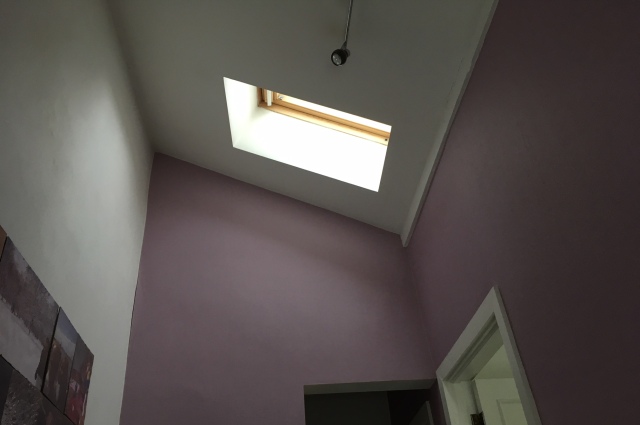Rooflight
Windows are openings fitted with glass to admit light and allow people to see out. They are often openable to allow ventilation. Rooflights (sometimes described as ‘roof lights’ or ‘skylights’) are windows built into the roof of a building.
Approved Document B2, ‘Fire safety: Buildings other than dwellinghouses’, defines a rooflight as:
| A dome light, lantern light, skylight, ridge light, glazed barrel vault or other element to admit daylight through a roof. |

|

|
Rooflights are effective at allowing natural light deep into the centre of a building, particularly where it is not possible to install windows in perimeter walls or where privacy is needed. Where they are openable, they can also be effective at promoting natural ventilation, as they tend to be at the top of buildings and so can benefit from the stack effect. They may also be used to allow access to roofs or to roof terraces.
Some rooflights however can be seen as a poor design solution, contributing little to the architectural form of a building, and simply creating a hole in a roof because without them there would be insufficient natural light. They can also suffer from ponding, dirt accumulation and staining.
Rooflights must have safety glazing, and if they are out of reach, may need a mechanism or motor to open them.
In some areas, some rooflights may be considered a permitted developments, not requiring planning permission. However, it is sensible to consult with the local planning authority to check this.
BS EN 14351-1 (Windows and doors. Product standard, performance characteristics. Windows and external pedestrian doorsets) suggests that the term ‘roof window’ refers to a window that is in the same plane as the surrounding roof, and has a minimum pitch of 15 degrees. This is as opposed to 'rooflights' which by this definition are installed on an upstand, and so are not in the same plane as the surrounding roof.
[edit] Related articles on Designing Buildings
- Aspects of daylighting design covered by EN 17037.
- Conservation rooflights.
- Designing daylight solutions for commercial buildings.
- Display window.
- Domestic windows.
- Dormer window.
- Double glazing.
- Easily accessible window.
- EN 17037 Daylight in buildings.
- Glass.
- Glazier.
- Glazing.
- How to waterproof a rooflight.
- Large rooflights.
- Light well.
- Rights to light.
- R-value.
- Secondary glazing.
- Steel framed rooflights.
- Structural glass assembly.
- Types of building EN 17037 applies to.
- U-What?
- Velux window.
- Window energy rating.
- Window.
Featured articles and news
Latest Build UK Building Safety Regime explainer published
Key elements in one short, now updated document.
UKGBC launch the UK Climate Resilience Roadmap
First guidance of its kind on direct climate impacts for the built environment and how it can adapt.
CLC Health, Safety and Wellbeing Strategy 2025
Launched by the Minister for Industry to look at fatalities on site, improving mental health and other issues.
One of the most impressive Victorian architects. Book review.
Common Assessment Standard now with building safety
New CAS update now includes mandatory building safety questions.
RTPI leader to become new CIOB Chief Executive Officer
Dr Victoria Hills MRTPI, FICE to take over after Caroline Gumble’s departure.
Social and affordable housing, a long term plan for delivery
The “Delivering a Decade of Renewal for Social and Affordable Housing” strategy sets out future path.
A change to adoptive architecture
Effects of global weather warming on architectural detailing, material choice and human interaction.
The proposed publicly owned and backed subsidiary of Homes England, to facilitate new homes.
How big is the problem and what can we do to mitigate the effects?
Overheating guidance and tools for building designers
A number of cool guides to help with the heat.
The UK's Modern Industrial Strategy: A 10 year plan
Previous consultation criticism, current key elements and general support with some persisting reservations.
Building Safety Regulator reforms
New roles, new staff and a new fast track service pave the way for a single construction regulator.
Architectural Technologist CPDs and Communications
CIAT CPD… and how you can do it!
Cooling centres and cool spaces
Managing extreme heat in cities by directing the public to places for heat stress relief and water sources.
Winter gardens: A brief history and warm variations
Extending the season with glass in different forms and terms.
Restoring Great Yarmouth's Winter Gardens
Transforming one of the least sustainable constructions imaginable.























